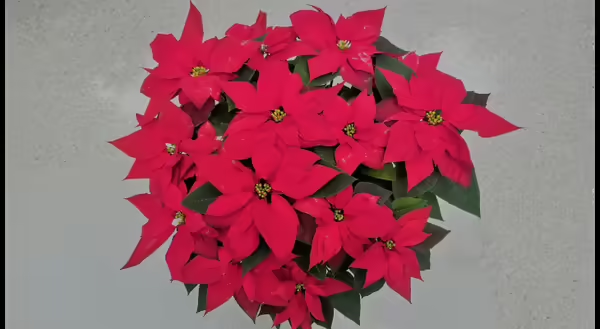
Are you searching for the perfect holiday gift for that plant lover on your list? Hoping to inspire a new plant enthusiast with the ideal plant-related gift? Houseplants are one of the best and most affordable gifts for someone interested in a plant-themed gift this holiday season.
Before you select that perfect specimen from the ranks of holiday plants for sale, it is helpful to consider some basic care requirements to be sure your plant’s recipient will be set up for success.
Poinsettias (Euphorbia pulcherrima) are the most popular holiday plant in the US, with around 30 million sold each year. Their beautiful, deep red foliage represents a quintessential shade of holiday color.
Unless you have close to ideal conditions for poinsettia growth, such as a green house, most of us will not be able to provide adequate care throughout the year in order to enjoy new blooms next holiday season. In most cases, they are simply a living floral arrangement for the holidays. For that reason, it is important to carefully select your plant to ensure the maximum floral display.
When selecting a poinsettia to bring home or for a gift, pay attention to the maturity of the flowers. Although most assume the beautiful red bracts, or modified leaves, are the flower structure, poinsettia flowers are actually tiny yellow clusters at the base of the bracts.
Select a plant with flowers that are green or red tipped and showing no signs of yellow pollen production because poinsettias drop their bracts and leaves soon after flowers shed their pollen. Choose plants with bracts that are fully colored red and do not have green around the edges. Make sure you select a plant with a balanced and attractive canopy of leaves. There should be evenly distributed, dark green foliage all the way down to the soil line.
During transport, take care to protect your newly purchased plant from cold air as they are very sensitive to cold. After the plant arrives at its new home, care should also be taken to shelter the plant from drafty windows or heating vents that cause dramatic swings in temperature. Poinsettias prefer fairly consistent soil moisture, but be sure to allow the soil to dry out between waterings because overwatering is major cause of reduced plant health and poor flower display. Select a location with full sun or very bright indirect light to ensure
Christmas cactus (Schlumbergera bridgesii) is another very poplar holiday plant with absolutely beautiful, draping blooms. Most garden centers have a large variety for sale this time of year in full bloom for the holidays.
I found that many retail outlets actually sell Thanksgiving cactus (Schlumbergera truncate) but market it as “Christmas cactus”. Since both species are stimulated to flower by the decreasing day length in fall, they can easily be manipulated to flower for either holiday under carefully controlled conditions. Both plants have very similar care requirements, so it really isn’t that big of an issue, although the flowering display next year may be closer to Thanksgiving if you aren’t able to carefully regulate light and temperature exposure.
Although these succulent plants are considered cacti, they are not the full-sun, desert loving species we typically think of. Instead they frequent the tree canopies of South American forests, living as epiphytes rooted into pockets of organic debris on tree branches, instead of soil. So, they prefer part sun to shade and very well drained soil, doing best in some kind of soilless potting mix designed for succulents. They certainly require less watering than most other houseplants, but their well-drained potting mix can sometimes dry out quickly in our drier, less humid winter home environments.
If you have someone on your list this year who doesn’t have the green thumb required to make a holiday cactus re-bloom next year, consider some of the non-holiday houseplants with less demanding care requirements.
Snake plant (Sansevieria trifasciata) is perfect for a home that doesn’t have full-sun, doing quite well in complete shade. Although spider plant (Chlorophytum comosum) does require slightly more light, it is a tough plant that can handle a wide range of indoor settings. In addition, there are a number of commonly sold varieties that offer somewhat differing foliage or character from the norm. There a tons of succulents available these days, with varying light requirements although most require minimal watering, making them relatively easy to care for.
I would argue that there is a houseplant out there for everyone, making them a wonderful gift idea this holiday season. With a little attention to their needs, they can provide beauty for years to come for both the avid plant collector and the beginner.